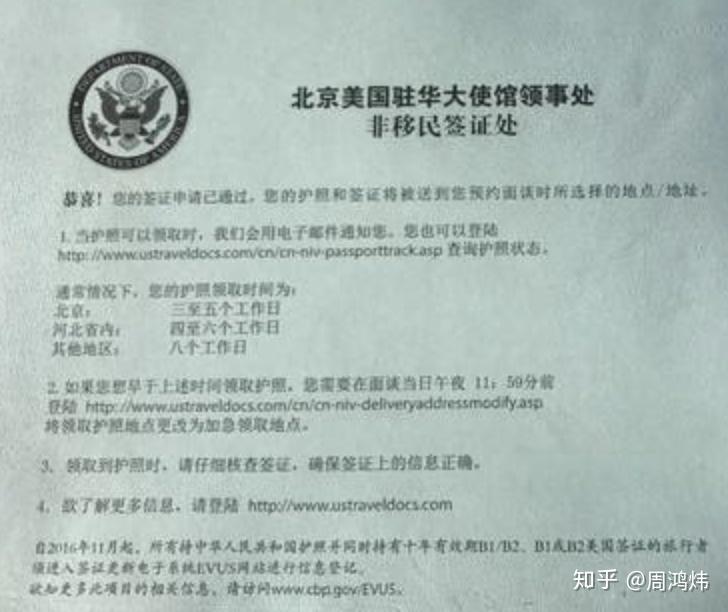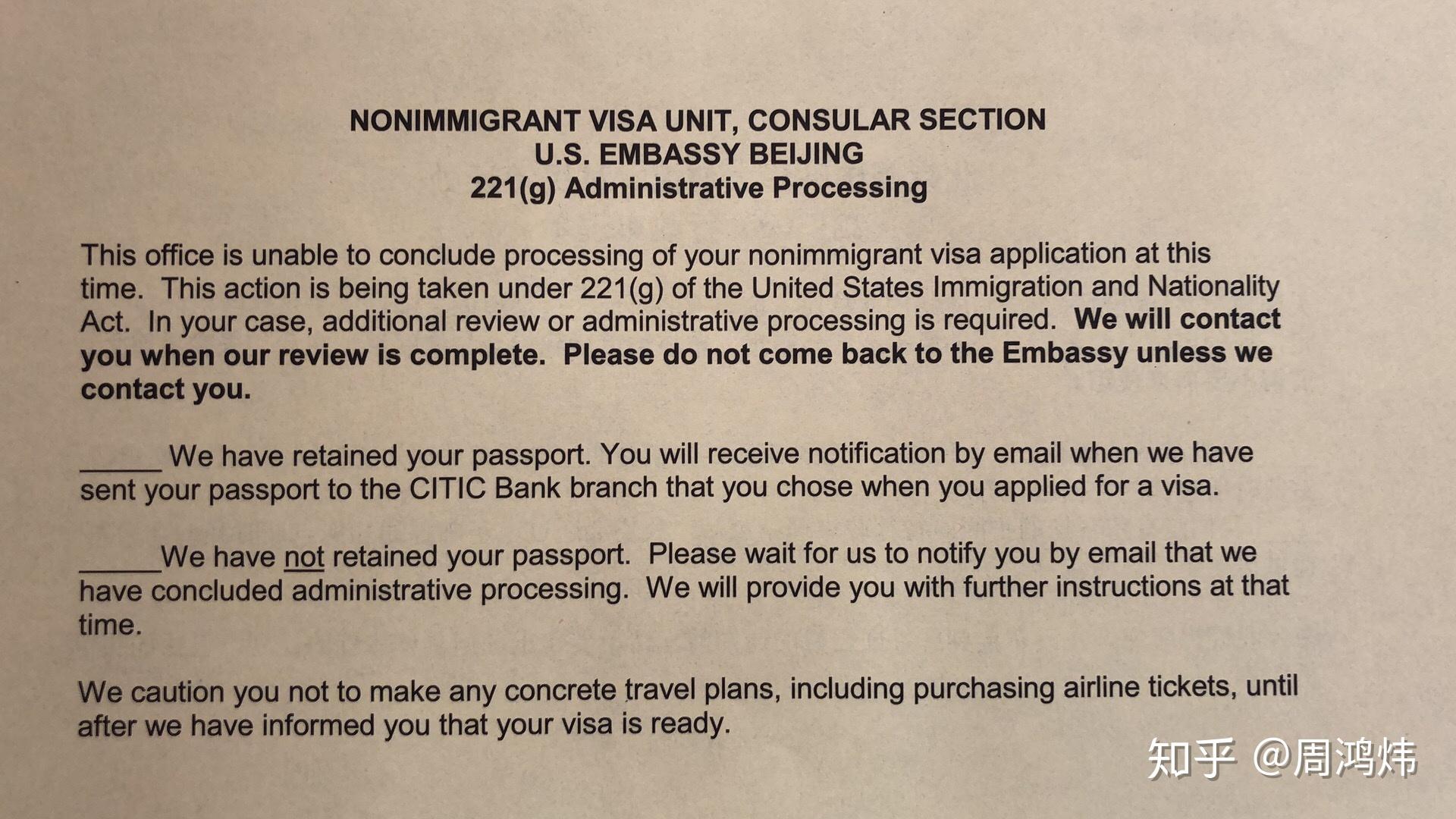

美国签证(美签)行政审查 Administrative Processing (AP) 国人俗称 "Check"。非美国大使馆或者美国移民局的工作人员,很难知道申请整个具体的审理流程。而美国大使馆或者移民局的工作人员更不可能透露具体的流程,只有相关的法律对公众透明。正因如此,也就导致了整个美签行政审查AP的过程可谓是捉摸不透。本文根据维基百科、历史被行政审查的案例,总结了常见的美签行政审查AP相关的可能原因,供美签申请人参考。为准备签证的申请人提供一个依据规范面签时中英文相关用语以减少被行政审查的可能。为已经在行政审查中的申请人提供一个参照的平台,疏解等待的压力。
在申请人到美国大使馆面试签证之后,一般会出现以下结果


行政审查是在面试官和美签申请人面谈之后,额外进行的对美签申请人和申请资料的审查。可以分为本地咨询复核 Local Advisory Review 和 安全监督意见 Security Advisory Opinion (SAO) or Washington Special Clearance。Local Advisory Review 主要是在面签结束后,由大使馆复核和重点抽查当天直接批准的美签签证,如果有安全或者其他的担忧,可转入 SAO;如果各方面都满足颁发签证要求,则直接签发签证。Local Advisory Review 主要由美国大使馆Local Consular Office(LCO)负责,如需进一步调查, 美国海外的大使馆(LCO) 会通过内部系统将签证申请材料传回总部华盛顿,同时请求多个SAO,由总部华盛顿的进行进一步审核。
美国大使馆LCO将根据面签的内容和申请人材料给华盛顿总部提交安全咨询意见Security Advisory Opinion 调查申请。Security Advisory Opinion 按照其不同的内容被以不同的动物名称命名如下:
如果申请人只是本地咨询复核Local Advisory Review, 申请进度查询时依然会显示Administrative Processing, 但一般会在两周内完成。对于安全咨询意见Security Advisory Opinion ,根据203(e)条款,221(g)行政审理为期一年,一年后将终止审理。美国移民局官方生命80%的安全咨询意见Security Advisory Opinion 调查在两周内完成,但是平均的通过调查的时间从3到48个月不等。同时也指出对于很多网站统计的时间并不能完全反应实际的调查时间。根据 the United States Government Accountability Office 在2004年的报告来看, 87% 的 Visas Mantis 的SAO 在30天内完成调查,5%的申请61-90天内完成,1%的申请91-120天内完成,同样有2%的申请需要超过120天的时间。2008年,受理Visas Mantis 平均需要6到8周。但是美国的官方统计是针对全球的申请者,同时也缺乏近期受理时间的声明。
因此对于世界各国的美签申请人也就诞生了不同的自主汇报行政审查AP/Check进度的网站
总目前来看整体中国的美签申请人如果被本地咨询复核 Local Advisory Review 两周以内基本出结果。安全监督意见 Security Advisory Opinion 出现了平均40天左右的长AP/Check 时间。对于近期的 Administrative Processing 我们也根据Checkee 对平均的等待时间做了分析,请参考
https://zhuanlan.zhihu.com/p/99138603访问以下网站随时查看申请状态: https://ceac.state.gov/ceac/
等待时间超过180天请到官网留言: https://china.usembassy-china.org.cn/zh/visas-zh/beijing-contact-us-zh/
咨询面签受理大使馆申请状态:
北京:
成都:
广州:
上海:
沈阳:
This cable updates the Technology Alert List (TAL) which was transmitted in November 2000, with particular attention to certain revisions as a result of the September 11 terrorist attacks. The cable also provides additional guidance for its use in cases that may fall under the purview of INA section 212 (a)(3)(a), which renders inadmissible aliens who there is reason to believe are seeking to enter the U.S. to violate U.S. laws prohibiting the export of goods, technology or sensitive information from the U.S.
TAB A - CRITICAL FIELDS LIST
A. CONVENTIONAL MUNITIONS: Technologies associated with:
B. NUCLEAR TECHNOLOGY: Technologies associated with production and use of nuclear material for both peaceful and military applications. Included are technologies for:
Also, certain associated technologies related to nuclear physics and/or nuclear engineering. Includes materials, equipment or technology associated with:
C. ROCKET SYSTEMS (including ballistic missile systems, space launch vehicles and sounding rockets) and Unmanned Air Vehicles (UAV) (including cruise missiles, target drones, and reconnaissance drones): Technologies associated with rocket systems and UAV systems. The technology needed to develop a satellite launch vehicle is virtually identical to that needed to build a ballistic missile.
D. ROCKET SYSTEM AND UNMANNED AIR VEHICLE (UAV) SUBSYSTEMS: Propulsion technologies include solid rocket motor stages, and liquid propellant engines. Other critical subsystems include re-entry vehicles, guidance sets, thrust vector controls and warhead safing, arming and fusing. Many of these technologies are dual-use. Technologies include:
E. NAVIGATION, AVIONICS AND FLIGHT CONTROL USEABLE IN ROCKET SYSTEMS AND UNMANNED AIR VEHICLES (UAV): These capabilities directly determine the delivery accuracy and lethality of both unguided and guided weapons. The long- term costs to design, build and apply these technologies have been a limiting proliferation factor. Technologies include those associated with:
F. CHEMICAL, BIOTECHNOLOGY AND BIOMEDICAL ENGINEERING: The technology used to produce chemical and biological weapons is inherently dual-use. The same technologies that could be applied to develop and produce chemical and biological weapons are used widely by civilian research laboratories and industry; these technologies are relatively common in many countries. Advanced biotechnology has the potential to support biological weapons research. In the biological area, look for interest in technologies associated with:
In the chemical area, look for:
G. REMOTE SENSING, IMAGING AND RECONNAISSANCE: Satellite and aircraft remote sensing technologies are inherently dual-use; increasingly sophisticated technologies can be used for civilian imagery projects or for military and intelligence reconnaissance activities. Drones and remotely piloted vehicles also augment satellite capabilities. Key-word associated technologies are:
H. ADVANCED COMPUTER/MICROELECTRONIC TECHNOLOGY: Advanced computers and software play a useful (but not necessarily critical) role in the development and deployment of missiles and missile systems, and in the development and production of nuclear weapons. Advanced computer capabilities are also used in over-the-horizon targeting, airborne early warning targeting, Electronic Countermeasures (ECM) processors. These technologies are associated with:
I. MATERIALS TECHNOLOGY: The metallic, ceramic and composite materials are primarily related to structural functions in aircraft, spacecraft, missiles, undersea vehicles, and propulsion devices. Polymers provide seals and sealants for containment of identified fluids and lubricants for various vehicles and devices. High-density graphite is used in missile nose tips, jet vanes, and nozzle throats. Selected specialty materials (i.e., stealth and the performance of these materials) provide critical capabilities that exploit electromagnetic absorption, magnetic, or superconductivity characteristics. These technologies are associated with:
J. INFORMATION SECURITY: Technologies associated with cryptography and cryptographic systems to ensure secrecy for communications, video, data and related software.
K. LASER AND DIRECTED ENERGY SYSTEMS TECHNOLOGY: Lasers have critical military applications, including incorporation in guided ordinance such as laser guided bombs and ranging devices. Directed energy technologies are used to generate electromagnetic radiation or particle beams and to project that energy on a specific target. Kinetic energy technologies are those used to impart a
high velocity to a mass and direct it to a target. Directed energy and kinetic energy technologies have potential utility in countering missiles and other applications. Look for technologies associated with:
L. SENSORS AND SENSOR TECHNOLOGY: Sensors provide real-time information and data, and could provide a significant military advantage in a conflict. Marine acoustics is critical in anti-submarine warfare; gravity meters are essential for missile launch calibration. Look for technologies associated with:
M. MARINE TECHNOLOGY: Marine technologies are often associated with submarines and other deep submersible vessels; propulsion systems designed for undersea use and navigation and quieting systems are associated with reducing detectability and enhancing operations survivability. Look for technologies connected with:
N. ROBOTICS: Technologies associated with:
O. URBAN PLANNING: Expertise in construction or design of systems or technologies necessary to sustain modern urban societies. (PLEASE NOTE: Urban Planning may not fall under the purview of INA section 212 (a)(3)(a), U.S. technology transfer laws, or any other U.S. law or regulation. However, Urban Planning is a special interest item and posts are requested to refer such visa application requests to CA/VO/L/C for further review.) Look for technologies/skills associated with: